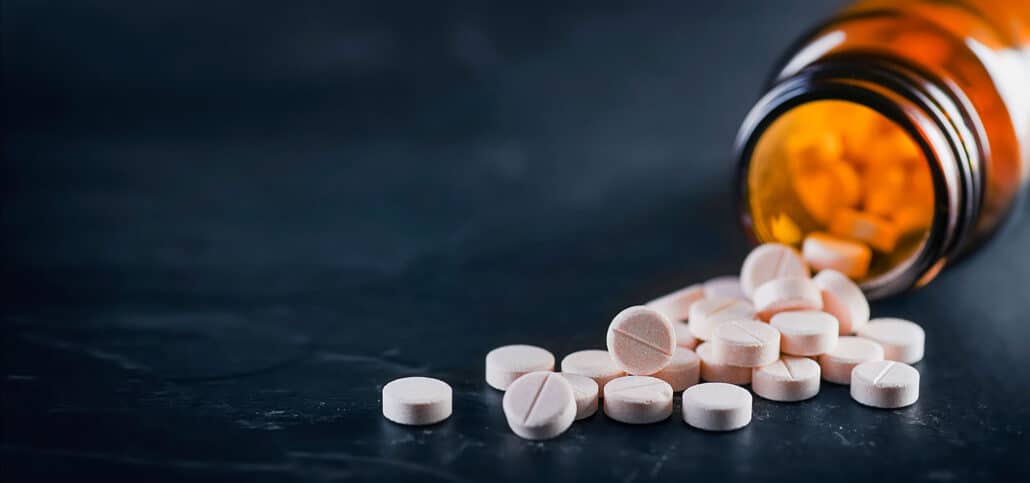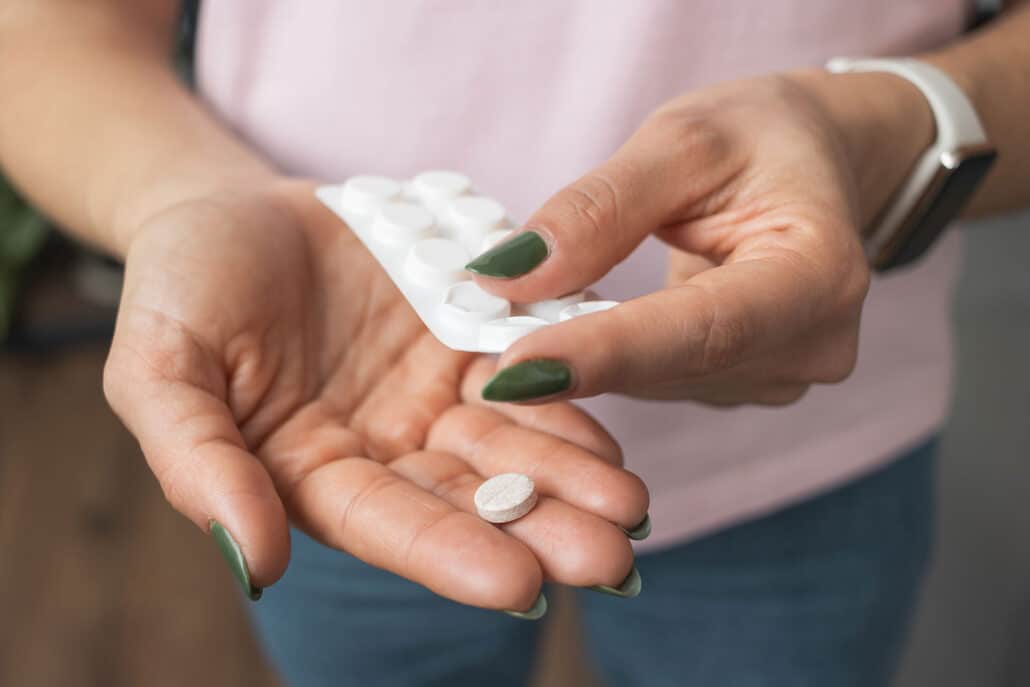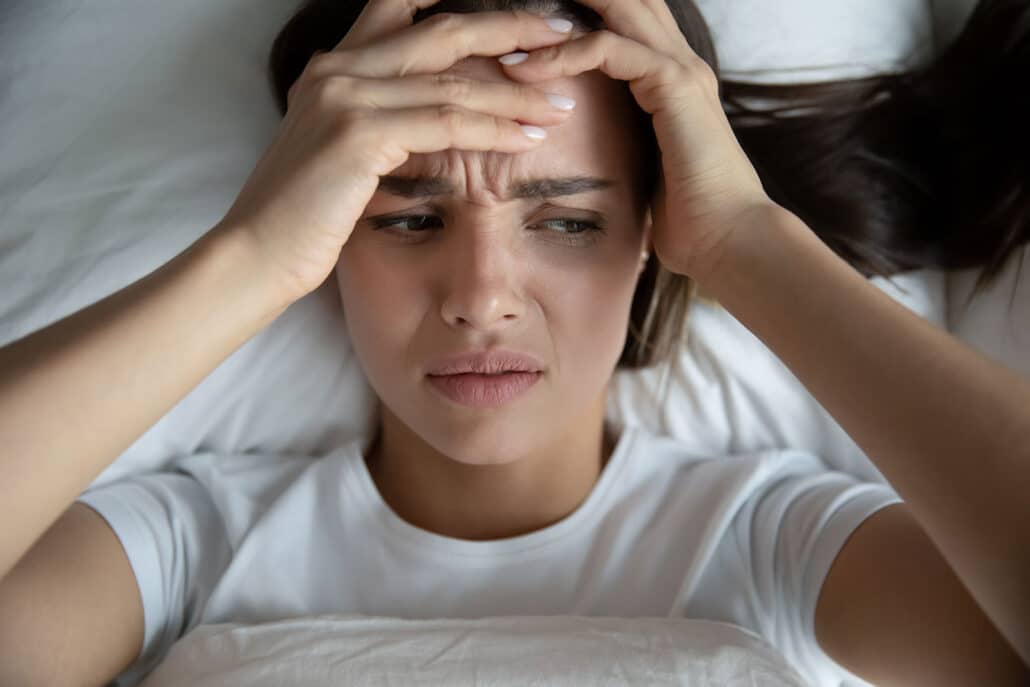Vicodin is a prescription pain reliever containing a combination of hydrocodone and acetaminophen. It treats moderate to severe pain due to injury, surgery, or chronic health conditions like arthritis.
Vicodin is an opioid medication that can lead to physical and psychological dependence when misused. Therefore, almost anyone can become addicted to Vicodin, although the risk may vary from person to person.
Vicodin addiction can lead to serious health risks and even death if left untreated. It is an opioid painkiller that can be highly addictive and lead to overdose or severe health complications. Treatment can help individuals overcome their addiction, reduce withdrawal symptoms, and prevent long-term damage to the body.

Table of Contents
What Is Vicodin?
Vicodin is a pain medication used to treat moderate to severe pain. It is a combination of the opioid hydrocodone and the non-opioid analgesic acetaminophen.
Hydrocodone binds to opioid receptors in the brain, reducing pain perception and increasing feelings of relaxation. Acetaminophen helps reduce fever and also provides some additional pain relief.
Vicodin is generally prescribed for short-term use only, as it can be habit-forming if taken for long periods. Common side effects of the drug are:
- Nausea
- Vomiting
- Constipation
- Dizziness
- Lightheadedness
- Sleepiness
In addition, long-term use can cause liver damage due to the acetaminophen component.
Doctors use Vicodin to treat pain caused by injury, surgery, or chronic conditions such as arthritis, back pain, and migraines. It also treats short-term pain associated with coughing, colds, and flu.
Most people associate Vicodin with its potential for abuse, addiction, and overdose. It is a potent opioid pain medication that is often habit-forming even when taken as prescribed.
If taken in large doses or mixed with other drugs or alcohol, Vicodin can cause serious health problems, including coma or death.
Who Is Most Susceptible to Vicodin Abuse?
Vicodin abuse is most common among adults ages 18-25. People with a history of substance abuse, mental health issues, or chronic pain are more likely to become addicted to Vicodin. People who have experienced trauma or have a family history of substance abuse are also at higher risk for Vicodin addiction.

Certain people may be more susceptible than others to Vicodin abuse due to a variety of factors, including:
- Genetics
- Mental health issues
- Environmental influences
- Peer pressure
People with a family history of substance abuse or addiction may be more likely to develop an addiction to Vicodin. Additionally, those with mental health conditions like depression or anxiety may turn to drugs like Vicodin to relieve their symptoms. Finally, people exposed to drug use in their environment or friends who use drugs may also be more likely to abuse Vicodin.
Vicodin Abuse Symptoms
Vicodin abuse often leads to physical dependence and addiction, which can have serious physical and mental health consequences. Knowing Vicodin abuse symptoms can help people recognize when they or someone they know is at risk of developing an addiction. It can also prompt them to seek treatment as soon as possible before the condition worsens.
Symptoms of Vicodin abuse include:
1. Increased Tolerance: Over time, a person who abuses Vicodin may need to take larger doses of the drug to achieve the same level of pain relief or euphoria.
2. Decreased Cognitive Function: Vicodin abuse can impair thinking, decision-making and concentration.
3. Changes in Mood: Vicodin abuse can cause significant changes in a person’s mood, including increased irritability, anxiety, and depression.
4. Impaired Coordination: A person who abuses Vicodin may have difficulty with coordination and balance, making activities like driving more dangerous than usual.
5. Withdrawal Symptoms: When people stop using Vicodin abruptly, they may experience withdrawal symptoms such as nausea, headaches, and muscle aches.
6. Risky Behaviors: People who abuse Vicodin may engage in adverse behaviors such as driving under the influence or engaging in illegal activity to obtain the drug.

Other signs of Vicodin abuse are:
- Changes in sleeping patterns or appetite
- Financial difficulties due to spending money on the drug
- Neglecting responsibilities at home or work
- Lying about drug use
- Problems with relationships
Symptoms of Vicodin abuse can vary, depending on a variety of factors, including:
- Age
- Gender
- Body chemistry
- Frequency of use
- Physical and mental health
Vicodin Withdrawal Symptoms
Knowing when a person is going through Vicodin withdrawal is crucial because it can prompt you to get help immediately. The effects of withdrawal can range from mild to severe and include:
- Nausea
- Vomiting
- Sweating
- Shaking
- Insomnia
- Anxiety
- Depression
- Irritability
- Cravings for the drug
If these signs are present in someone taking Vicodin regularly or for an extended period, seek medical attention as soon as possible.
Treating Vicodin Withdrawal Symptoms
Vicodin withdrawal symptoms should only be treated by a qualified medical professional, such as a doctor or psychiatrist. They can provide medications and other treatments to help manage the symptoms and allow the patient to safely and effectively withdraw from Vicodin.

A slow taper of Vicodin can help minimize withdrawal symptoms. However, you should only consider taking this step under medical supervision.
Doctors and other medical care providers can also use medications such as clonidine, anticonvulsants, and antidepressants to address specific withdrawal symptoms such as:
- Anxiety
- Agitation
- Nausea
- Vomiting
- Insomnia
- Pain
Different people will react differently to Vicodin withdrawal treatment, which typically involves a combination of medications and cognitive behavioral therapy. In addition, post-treatment strategies often include counseling to help the patient cope with the emotional and physical symptoms of withdrawal.
Treating Vicodin Addiction
Below is a list of ways to treat Vicodin addiction. However, remember that every person is different in how they interact with these therapies. For this reason, it is best to seek a treatment plan that fits individual needs.
1. Seek Professional Help: Seeking professional help is the most critical step in treating Vicodin addiction. A doctor or mental health professional can provide a unique treatment plan that best suits the individual’s needs. This step may include medication-assisted treatment, psychotherapy, and addiction counseling.
2. Detoxification: Detoxification removes toxic substances from the body. During this process, individuals may experience uncomfortable withdrawal symptoms such as nausea, vomiting, and anxiety. Medical supervision is essential during detox to ensure safety and comfort and to help manage these symptoms.
3. Behavioral Therapy: Behavioral therapy addresses underlying issues contributing to the addiction and helps individuals develop new coping skills for managing stress or triggers without using Vicodin. Dialectical behavior therapy (DBT) and cognitive behavioral therapy (CBT) are two examples often used to treat Vicodin addiction.
4. Support Groups: Support groups provide a safe space for individuals to connect with others. Bonding with people who have gone through similar addictions provides a sense of community. It also fosters understanding while offering advice on how to stay sober in recovery.
5. Alternative Therapies: Alternative therapies such as yoga, meditation, art therapy, journaling, and music therapy are complementary treatments for managing stress or cravings without relying on Vicodin use. These activities can also help individuals reconnect with themselves emotionally during recovery from an addiction disorder.
People react to Vicodin addiction treatment in different ways. Ultimately, it depends on the individual’s attitude towards addiction and the support they receive from family and friends. Therefore, individuals need to find a treatment program that works for them, including a supportive network of people who can help them through the process.

Getting Help
Getting help with Vicodin addiction is essential. Trained medical professionals help an individual safely and effectively manage their addiction and reduce the risk of further health complications.
Treatment may include detoxification, counseling, lifestyle changes, and medications to reduce withdrawal symptoms. With professional help, a person can learn how to cope with their cravings and manage their addiction so that it does not take over their life.
If you or a loved one is fighting an addiction to Vicodin, help is available at Long Island Interventions. We offer New Yorkers a range of resources to support them on their journey to recovery.
We understand that Vicodin can cause abuse disorders, even when prescribed. If mental illnesses are also present, things can become more complicated. Our staff is trained to address co-occurring conditions as well.
We put you in touch with conventional therapies and holistic treatments that focus on the physical, mental, and spiritual aspects of recovery. Our ultimate goal is to help individuals achieve lasting sobriety.
For more information, please contact Long Island Interventions to learn more!
FAQ
What was vicodin originally used for?

